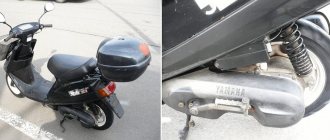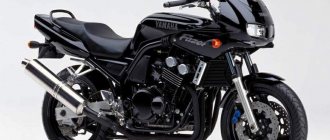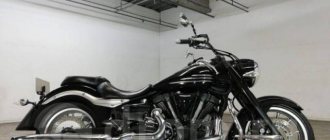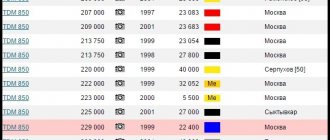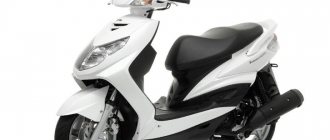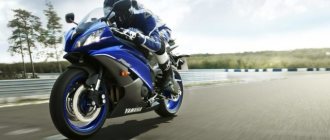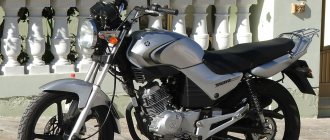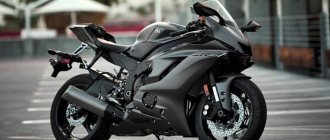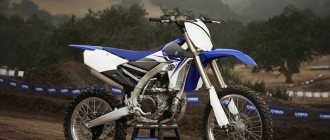Simplicity and reliability are the main advantages of this model. As for comfort, speed, directional stability and noise level, all this is clearly not at the highest level. The Yamaha CPX 400 is a simple motorcycle for those who love road bikes from the nineties and are inclined to ride on the streets rather than on windswept roads.
Despite its simplicity, the model demonstrates average characteristics for its time. A motorcycle, in principle, can even be used for traveling on a country road, but you must understand that the roar of the engine will sooner or later tire you, and this motorcycle will not ignore gusts of wind.
Engine
The engine of this bike is borrowed from the XT 400, a fairly old enduro. The engine now has an electric starter, but it has been deprived of a kickstarter. In addition, the power was slightly reduced - to 33 hp. Cooling here is air-oil. This allows the SRX 400 to accelerate to hundreds in just over six seconds and reach a top speed of 140 km/h. But it is worth considering that when crossing the threshold of 110 km/h, the motorcycle begins to roar too much and vibrations that are unpleasant for the motorcyclist appear.
Yamaha SRX 400 motorcycle review
Design
Of course, there is nothing flashy or super fashionable, just a classic look. In combination with driving performance it goes well, in my opinion.
Comfort
With my height (more than 190 cm), at first my legs felt numb, and even now it’s the same during long trips. At the same time, you don’t feel tired in your back. The absence of a windshield on the srx 400, in principle, does not affect anything in this model. It handles easily, almost like a bicycle. And its weight, I tell you, is not heavy at all - about 130 kg. The most suitable speed for me on it is up to one hundred.
Safety.
What can I say - all motorcycles are dangerous as soon as you sit on them)) Seriously, this indicator is a solid “B”. It often forgives minor mistakes; when you don’t notice a lying policeman, it won’t throw you off the saddle. But I wouldn’t recommend being particularly reckless or careless.
Reliability.
Here I will say on emotions - I don’t-have-a-bi-va-eat a motorcycle! It’s even difficult to imagine how it needs to be destroyed so that parts or mechanisms begin to break. There are not many horses, but enough for a 400cc enduro engine. All this creates a decent amount of traction, and the resource increases significantly - I recommend checking it out from personal experience. An air-oil cooling system is installed - a fact is a fact, although in Moscow traffic jams it’s not exactly what is needed.
Among the things I'm not happy with: the rear spring is too soft. Gear shifting is also a bit difficult. But in this I make allowance for the significant age and mileage of the moto.
Driving characteristics of Yamaha SRX400
I tested them not only in my town and the capital, but also traveled a lot during the season - regular forays into nature, along dirt and country roads. That's when I really enjoyed traveling. Motz has excellent road holding and balance, but of course he didn’t risk getting into obvious swamps and sand dunes.
The tank is designed for 14 liters, the consumption is very small. I didn’t skimp on gasoline; I filled it with 95 for reliability and confidence. The maximum speed for this modification is 130 km/h, which is clearly an unnecessary limit. In general, after a hundred dynamics are lost, it is clear that speed is not exactly its advantage.
To summarize the advantages: the Yamaha srx400 has no problems with reliability, fuel consumption is low, the device is lightweight, and it’s not difficult to pull it out of the swamp and lift it. All advantages are completed by low cost, even for a student. Of course, with time and experience you begin to want to ride at higher speeds, and the low weight on the track turns into a disadvantage. That's all. Start with this, I advise.
I took my Yamaha SRX400 almost antique - 1989. Of course, due to the low cost. Time and the previous owners have taken a beating on the device. I replaced a lot of things at once, the rest gradually. I immediately decided to dig up information on the forums about the Yamaha SRX 400, and compiled a list of the main problems. I took the same parts as for the 600 - they fit perfectly, are easier to find, and therefore the price is lower. I recommend not delaying the installation of the sprocket-chain kit, only after that start running it in full.
Although it is ancient, I like the design, nothing superfluous, classic. The single-cylinder enduro engine is reliable and will endure a lot without complaining or chugging. The gearbox is more problematic, but I attribute this to old age. The engine corrects all shortcomings by smooth operation. Thirty-three horses is not enough, of course, but it’s enough for a horse with such a light weight.
I wouldn’t say that I’m gluttonous in terms of oil - it takes about 100 ml per km - you agree, quite a bit. The chassis is designed for quiet driving, the braking system is also not for extreme sports. However, I am still not disappointed with the handling of the SRX 400. And in traffic jams, I haven’t seen a better stitcher. Benz also doesn’t take much - about five liters. But for lovers of tracks, overtaking and speed, this is definitely not an option. For all the time it broke in one place - it broke the gasket, the one under the cylinder. If you want a reliable companion for daily driving around the city and to the country, don’t think about it!
Dimensions and weight
Weight of 170 kg including fuel is a fairly typical figure for this type of bike of that time. Especially when you consider that the gas tank volume is 15 liters. The motorcycle is small: the seat height is 760 mm, while the wheelbase is only 1425 mm.
Ride quality and comfort
The Yamaha SRX 400 is a motorcycle of such a class that there is no need to talk about comfort. The owner is increasingly thinking about how to quickly get through a traffic jam. And outside the city on the highway the motorcycle has other problems: headwind or side wind and engine vibrations at a speed of about 120 km/h. These factors make you think not about comfort, but about how to avoid driving into a ditch. The short wheelbase also adds problems. The car bounces off any unevenness in the road surface, and a side gust of wind can aggravate the instability.
Chassis and brakes
The suspension here is unremarkable: a typical swingarm with a shock absorber at the rear, and again a typical telescopic fork at the front. Another thing is the brakes. If the rear is represented by a very symbolic disc with a single-piston caliper and is auxiliary, then the front has a 320 mm disc, and the caliper here is already two-piston.
As for the exterior, it is gorgeous in its own way. Yes, it may not be distinguished by the luxury of its forms, but its classicism and abundance of chrome cannot go unnoticed. The motorcycle seems frozen at the turn of the century and represents the road class of the nineties.
Let's plunge back into that wonderful time, hmm, at the beginning of 2021, somewhere at the end of March: There is no impact on daily life yet, but the stock exchanges have already fallen, which is symptomatic;
reports from the eastern and then western fronts resemble Trofim’s song about the news; comes the realization that very soon there will be very little work, a lot of extra time that needs to be occupied with something, and a lot of reasons to find this activity inside your home. So an idea came to me: I need to find a very cheap dead motorcycle that can be turned into an interesting living one. Or at least try to make money in such a non-linear way. Soon the idea became more precise: since I don’t want to sell my second car (Kawasaki ZL400), for me alone it’s too much to have two motorcycles, considering that I don’t even ride 5 thousand kilometers per season on one, and my wife’s right to change is coming due - it’s necessary look for a motorcycle suitable for a beginner. Quite quickly I settled on the SRX - as in the case of my ZL, the device simply has no analogues in its class. This is a single-cylinder engine that promised a comfortable “civilian” character, but due to four valves it had an acceptable power of 33 horsepower. It has a low weight of 150 kg, a short wheelbase, low seat height, and a fairly powerful front brake. Having a developed imagination, I made conclusions about all this by looking at the numbers. It was necessary to achieve all this from a real motorcycle, but more on that later. In any case, in the process of choosing a workpiece, you need to determine the potential, right? He seemed to me like something like a “Chinese at maximum speed.” In principle, this is not too far from the truth, in my opinion. Almost everything good that I remembered from my first moped, and that was not in the ZL, was found here in the end.
So, there is an image of what you want to come to - now you need to find the starting point. At the time, there were two options in the region - for 40k without details, and for 35k not running and without documents. In the end, I was unable to reach the device without details, so the only one left was the second one. The lack of documents was a little stressful, but on the other hand, this was also an experience that I had to go through for the first time, there was a certain inspiration of the researcher - that whether it would succeed or not, I would learn something new. In the end, it didn’t take too long to convince myself. There is another post in the BZ about how this particular scourge was overcome, the details are there.
Now about the interesting appearance in which it appeared before me when I came to inspect it for the first time in a village 60 km from my home: It all started with the fact that the battery was dead. At the very least, using the wires, we managed to start the motor on the enrichment unit, but it only worked on the enrichment unit; there was no idle at all. The next thing I noticed was the very heavy clutch lever, and the front brake lever, welded from a bicycle one. It was very difficult to roll the bike with the clutch depressed. At that time, I chalked it up to biting brakes or wheel bearings. The gears were also engaged with difficulty and with shocks, but since the minimum engine speed was 3 thousand out of 7, I considered that this was not a separate problem. Oh yes, of course... The muffler bore traces of falls, and a welded pipe with a diameter of ~80mm, a wall thickness of 2mm and a length of about 40cm. Obviously, riding in a village without such a “male” is still not comme il faut. The car was, ahem, “restored” after an accident in 2010, and there were traces of this everywhere: in addition to the brake lever, there was a small dent on the frame on the right, an exhaust pipe, a bent but intact oil cooler, a homemade rear brake foot, a putty dent on the tank , the tail plastic was missing and was replaced with something homemade. The fork looked straight, stiff but functional, and had some corrugations on it. Upon inspection, I moved these corrugations upward, compressing them in half, and found underneath them clean working surfaces without smudges or deformations. I calmed down, considering that the plug had been replaced. Also required was a chain replacement, a search for air leaks from the tires, turn signals and mirrors, a set of locks, grips, footrests and other expected items.
This is how he basically came to my garage. The initial plan was this: before besieging the guys with the docks, it was necessary to understand that the apparatus was generally viable. It was necessary to make it so that it could be ridden somehow. So that it is idle, so that the controls work predictably. Since the status of the venture gradually changed for the better, my readiness to invest changed. At the very beginning, it was necessary to achieve maximum results at the minimum cost (there was no way to earn money!), and only gradually, as I understood the progress, did I agree to higher costs.
The compression test showed 11 points. The carburetor showed a dense layer of green deposits everywhere, including the XX jet, a cracked membrane, and a generally neglected condition. It was cleaned, the membrane was temporarily sealed, and a membrane from Steed that was suitable in geometry was ordered to replace it in China. The spark plug was replaced and a fuel filter was installed. After these manipulations, the idle appeared, albeit floating. This engine has a dry sump lubrication system, so every beginner with such engines made a mistake: no oil was detected on the dipstick, and therefore it was immediately overfilled to the point that foam came out of the neck. However, this did not lead to anything terrible, except for accelerated googling of the missing information and bringing the level back to normal.
Then the fork threw a surprise. A slightly more detailed inspection showed that the corrugations had outwitted me.
If I moved them not up, but down, then what would appear before me was not a clean work surface, but a pipe welded into the feathers. How did it all work? The fork had half its travel left, springs from Izh with a smaller diameter and greater rigidity were inserted inside the pipe, and instead of oil, what felt like a very high viscosity transmission was poured. Oddly enough, it was really possible to move in space on this one, as long as you did not go beyond the short working stroke, which only happened to it when hitting very holes. In general, having decided to take live feathers after receiving the dockets, I put this thing back together and continued with other problems.
The tanks on these motorcycles suffer from water not draining in their pockets and rot to the point of holes. I cleaned the tank using a bunch of self-tapping screws, a vibration grinder and a rust converter (Yaskhim with hydrochloric acid corrodes much more effectively than zinc, by the way), after which the remaining acid must be extinguished by repeated washing with soda. As they say, before and after:
Next came the clutch. As it turned out, the whole point was that due to the use of some incorrect oil, the clutch discs naturally stuck together, and as a result, the clutch simply did not open completely. Three more days of fussing, and with the help of the mind of the hive they also figured it out.
Little by little, goodies began to arrive from China - a brake lever for some Chinese enduro (after some modifications on a sharpener it snapped into place like it was original), pegs, a steed membrane. After installing all this, I was already able to do some test ride to a gas station in a neighboring village, which showed that in general it is possible to make it go.
Although, of course, much still remained to be done. The chain was unevenly stretched; the front brake showed a lot of disc runout, which caused a huge empty stroke of the lever due to the pads being too far apart; Although the fork allowed some control, the need for replacement was obvious; The battery gave out the last couple of cycles and finally died; the heavy “male” on the glushak, as it turned out, led to the complete destruction of the glushak’s suspension, which is why it knocked on the frame on every bump; The idle turned out to be unstable and prone to freezing.
Since everything except XX required investment, I did it almost all the time until the situation with the documents was resolved, which took about another month. Little things on the ground were found in stores for Soviets and Chinese: turns, mirrors, a suitable 428 chain, made up of two from a “Mukhtar” motorized dog. The carb was removed an extra five times, looked for, and was never found for an air leak in front of the carb. Everything is complicated by the fact that it has a YDIS carburetor - a two-chamber carburetor, very vaguely reminiscent in principle of operation of the Zhiguli Ozone, familiar to all necromancers. Namely, it has a mechanical drive for the primary chamber damper, and a vacuum drive for the secondary one. True, this is where the similarity with Ozone ends, but the underlying idea is the same: to use only half of the intake capacity at low speeds. In fact, on the SRX, before the secondary chamber opens, only half of the intake works, since the secondary closes tightly - and although the right intake valve of the engine opens, the mixture does not pass through it, and the primary chamber receives a vacuum for two. As you might guess, you can look for problems in this thing for a long time. As a result, all of them have not been found until now. The tendency for the idle to freeze, which manifests itself in proportion to temperature, was slightly reduced by raising the needle in the primary so that the mixture was a little richer and the engine would heat up less. As a result, if you don’t stand still for a long time, overheating the engine, the idle is quite predictable. But, on the good side, here you need to arm yourself with a set of jets, time and desire to select them for a long time by scientific poking. It hasn't come to that yet.
As soon as the problem with the docks was resolved in our favor, little by little I began to buy more expensive ingredients for Frankenshain-style herring: fork feathers were found inexpensively after a slight fall, one was straight, the other required a little straightening; Locks, LED headlight, stoppers, reinforced hose for the front brake were purchased in China. The brake itself, towards the end of the season, was brought back to normal by straightening the aluminum base of the floating brake disc - apparently, the consequences of an accident remained on it, but nothing that could not be corrected with the help of precision tools - a dial indicator and a mallet.
Somewhere around this time, I thought of looking at the inside of the tank with an endoscope, and was surprised to discover that the tank was not just puttied crookedly, but a piece of large diameter pipe was welded into it instead of a dent. To fix this, you will probably need a kilogram of putty on each side. Thus, with the hope of returning him to form, I said goodbye; It is almost impossible to find a tank for this motor on the secondary market due to their tendency to rot where water that is not drained accumulates. Therefore, ideas began to accumulate on how to beat the asymmetrical tank when painting.
After all this was installed, I started driving it to identify further problems. And little by little we began to teach my wife basic riding techniques - to start, stop, and understand how, in principle, a motorcycle is controlled by the steering wheel. Then it became clear that our apparatus was not very suitable for basic training. At low speeds, the large single-barrel gun operates jerkily, and this is very disturbing for a complete beginner. Plus, the air engine begins to overheat, the idle starts to rise, which we were never able to conquer completely, this makes adjustments to everything else... in general, we had to go conquer the motorcycle school stealth flex, and by the end of the year we were not able to pass the test. for a bunch of reasons not related to the topic. Currently I have two motorcycles, and my wife does not have an A-category. However, all meaningful work has moved online over the year, and I’m warmed by the thought of moving south, to the edges of the eternal season, so that I have a reason to completely sell my car - so the category will still be needed, but that’s a completely different story, and not really about motorcycles ...
Despite certain problems, including with symmetry, I was pleasantly surprised. The device is very easy and pleasant to operate in confined spaces. Coincidentally, in my area it was this year that they began to build an interchange, the long-existing transport problem became twice as acute, and as a result, for almost six months, every time I needed to get to the city, I took the herring. For this passage of bottlenecks, it can be forgiven for everything, including the problems of this particular specimen. Generally speaking, I don’t like row spacing. I don’t feel comfortable in them, I prefer a kind of physical loneliness in space so that my mind isn’t distracted by the noise around me. But if your goal is to overcome this discomfort in a short time, then you need just such a motorcycle. It seems to listen to thoughts, compared to the ZL with its low center of gravity, greater mass and width. A bonus is low operating costs - a low tax rate for 33 horsepower, a ridiculous consumption of 4.5 liters - and in general my mopeds complement each other: one is nice to ride with two people or with bags for a hundred or two kilometers, and the second is convenient for one person to go through a traffic jam to the city for something that fits in a backpack.
As a result, we managed to get about 1.5-2tkm on it over the rest of the season. I drove the last kilometers at near-zero temperatures, and then the opposite problem arose - if in the summer it overheated in some conditions, then in the “winter” it underheats, and because of this it is necessary to tighten the idle. Logically, there is nothing in the design that resembles a thermostat. Neither in the oil cooling circuit, nor, especially, in the aluminum fins. Here I want to ask my fellow air-coolers how normal this is. I am not as familiar with it as I am with liquid to draw conclusions.
I hope that I will have more to write about it - a complete disassembly, painting, experiments with fiberglass to make new plastic elements to replace the lost ones, a 520 chain, and many other small improvements were planned for the winter. But it seems that the delivery of ingredients is being delayed, and besides, now I’m particularly overwhelmed by winter, laziness, gaming and graphomania, all this will happen in 2021. And the post has already turned out to be such that it’s time to divide it into three - it’s time to know the honor. I'm looking forward to your feedback and to be continued...?


